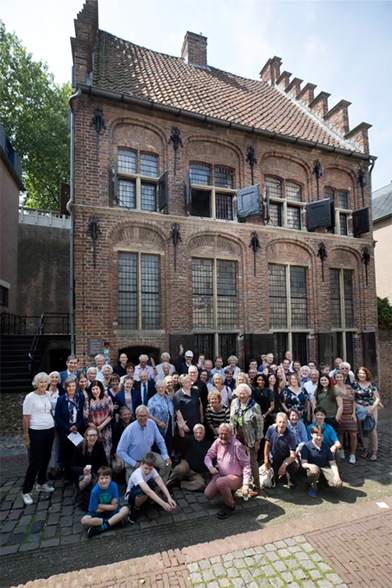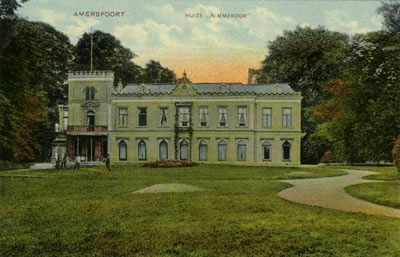Article taken from De Colve XIII – 2008: The House Nimmerdor

Kolffs at Amersfoort - the 'Nimmerdor' estate (1), by Bertie (G.W.) Nix- Kolff (CBCF XVIaa1)
The House ‘Nimmerdor’, the creation and the changes
‘Nimmerdor’ is one of the creations of Everhard Meyster, an Amersfoort citizen known as eccentric, who lived from approx. 1617- 1679. The up to this day famous Amersfoort Rock (Amersfoortse Kei), was taken by him to the city. Meyster could not – being a Roman Catholic – have a public function. He used his wealth and his money amongst other things on the cultivation of the moors around Amersfoort and to erect estates as iddyllic spots, of which ‘Nimmerdor’ was the most important one. He recieved many guests here, very often from artistic circles. One of his guests has been Constantijn Huygens in 1669, who praised this visit in his diary.
 Of all his creations ‘Nimmerdor’ is the only example of the ever green ‘hof’ (court, park), designed and created with ever green bushes and trees such as firs and spruces, holly, ivy, and savin. The park was finished in 1655. After Meysters’ death in 1679 his widow Agatha Schaap sold the possessions in parts to several buyers as we can see from title-deeds. At a public auction ‘Nimmerdor’ is sold in September 1682 to Dirk van Ommeren, former mayor of Amersfoort. Around 1715 Van Ommeren sold the estate to Cornelis Wijborgh, mayor of Amersfoort. Thirty years later the heirlooms Wijborgh sold ‘Nimmerdor’ to Laurentius Grothe. At this time the estate consists of several houses such as a gardeners cottages, a farm, and barns.
Of all his creations ‘Nimmerdor’ is the only example of the ever green ‘hof’ (court, park), designed and created with ever green bushes and trees such as firs and spruces, holly, ivy, and savin. The park was finished in 1655. After Meysters’ death in 1679 his widow Agatha Schaap sold the possessions in parts to several buyers as we can see from title-deeds. At a public auction ‘Nimmerdor’ is sold in September 1682 to Dirk van Ommeren, former mayor of Amersfoort. Around 1715 Van Ommeren sold the estate to Cornelis Wijborgh, mayor of Amersfoort. Thirty years later the heirlooms Wijborgh sold ‘Nimmerdor’ to Laurentius Grothe. At this time the estate consists of several houses such as a gardeners cottages, a farm, and barns.
The Amsterdam Courant wrote in 1746 about an extension of ‘Nimmerdor’ of 54 ‘morgen’ (one ‘morgen’ = approx. 2 acres), consisting of ponds, hollows, canals, oaks and beeches! In 1788 the estate is rented out to the lady Maria Soet, the ‘separated housewife’ of Mr. A.C. Josephe. From 1846 the estate is owned by Mrs. A. Pompe van Meerdervoort, widow of F.J. Pigaud (LL.M.), bailiff at Amersfoort. Later the estate is owned by her daughter Johanna Antonia Pigaud. From about 1881 to 1915 the estate is the property of Margaretha Laurentina de Beaufort, spouse of H.J.H. baron van Boetzelaer van Oosterhout. The municipality of Amersfoort tries to buy the estate in 1911, which has – luckily – been rejected by the States of Utrecht. In that year my Grandfather Gualtherus Kolff, married to Helene Mathilde Voss, hires the estate. In 1915 he bought it.
A personal note…
From the preceeding it appears that us Kolffs: Grandfather, my Father and me, are the longest residents of ‘Nimmerdor’.
When my grandparents came there, my aunt Tilly (1899-1970) was twelve years old. She amd my father, who was then one year old, were both born at Amsterdam in the Vondelstraat. My grandfather was a broker in shares in that city.
World War I did not affect ‘Nimmerdor’ much, just some inconveniences: Grandfather “had to leave at 6 a.m. to be on time in Amsterdam!”

In World War II the history of ‘Nimmerdor’ was more tempestious. On May 10, 1940, ’the big house’ (the old name for Nimmerdor) was confiscated by the Germans. When they left, after a week, the house was ran down and stripped empty… Grandmother and aunt Tilly lived in one of the gardeners cottages. We, my father Dick, mother Charlotte, and me, first lived in a street and later also in one of the gardeners cottages on the estate. Many times we got military quartered.In the beginning of 1945 Nimmerdor suffered most: led by Germans Dutchmen came to dig anti-tank ditches, many pines were cut. Many trees were also destroyed because their tops got hit by missiles, some of which we still find.
On April 24, 1945, the big house was almost completely destroyed by British bombs: “wrong information”!
It has cost my father ten years to get permission from the municipality of Amersfoort to clear up the ruins! In 1975 he built the present big house; to rebuild it in its former style appeared impossible.
This is the history of ‘Nimmerdor’, this place – for the present residents, our family Nix-Kolff – so dear in our hearts.
Bertie (G.W.) Nix- Kolff